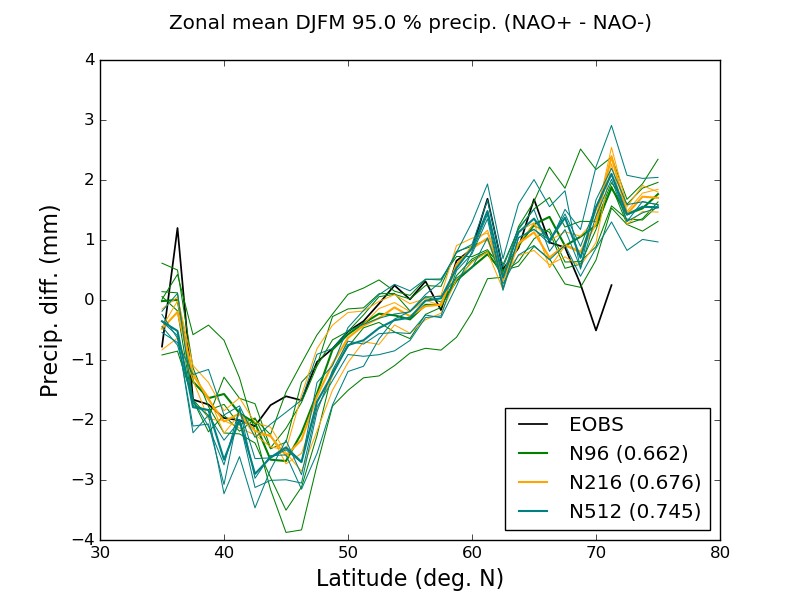Plot of the month for February 2017 is provided by Alexander Baker, who characterises the relationship between European extreme precipitation and the North Atlantic Oscillation.
The effects of atmospheric modes of variability, such as the North Atlantic Oscillation (NAO), on the spatiotemporal distribution of European mean precipitation are relatively well-documented, but less is known about their impact on precipitation extremes. It is important to determine how well GCMs represent relationships between extremes and large-scale modes of atmospheric circulation variability, particularly for understanding the implications of a given medium-range or seasonal NAO forecast for extreme precipitation. Here, we evaluate the resolution sensitivity of European extreme precipitation (95th percentile) in gridded observations (ECA&D E-OBS) and in an ensemble of atmosphere-only HadGEM3-GA3 simulations (from the UPSCALE project), in which mid-latitude horizontal resolution is increased from ~135 (N96) to ~25km (N512).
We computed daily NAO indices from the mean sea level pressure field, composited the 95th percentile of daily winter precipitation, and reduced this to a zonal mean field (see figure). In this example, the large-scale pattern – wet north-western Europe and dry southern Europe – is reproduced by HadGEM3-GA3. However, the response of extreme precipitation between ~40-50°N to NAO phase is overestimated across the resolution hierarchy and the variability between 58-65°N is captured only at N512 resolution, likely due to its better representation of Norwegian topography.

Figure | Zonal mean (-40-60 E) difference between European extreme winter precipitation (December-March) under NAO+ vs NAO- regimes in gridded observations (EOBS) and HadGEM3-GA3.0 simulations, with horizontal resolutions of ~130km (N96), ~60km (N216) and ~25km (N512). Precipitation over land only. Values in legend give ensemble mean root-mean-square error (model-EOBS).
Ongoing work is extending such analyses to multiple atmosphere-only and coupled models within PRIMAVERA and associating extreme precipitation to phenomena whose frequency is impacted by large-scale variability, such as extratropical cyclones. Overall, this work aims to develop our understanding of the implications of a given medium-range or seasonal NAO forecast for extreme precipitation across Europe.
This is ongoing research.